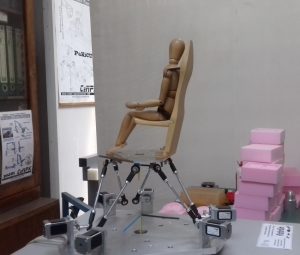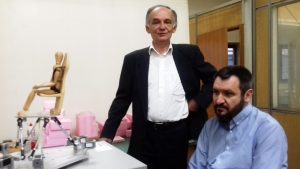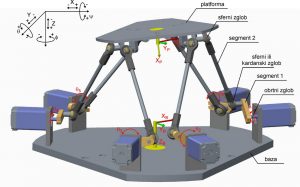 The moving platform for realistic flight and driving simulators, developed by Professor Dragan Milutinović, is only one in the vast array of current projects of the researchers at the Industrial Robotics and Artificial Intelligence Laboratory of the Faculty of Mechanical Engineering. The cutting-edge platform is intended for making simulators for various kinds of vehicles, such as aircraft, armoured personnel carriers or construction machinery, says Professor Milutinović, who is also the Head of the Laboratory.
The moving platform for realistic flight and driving simulators, developed by Professor Dragan Milutinović, is only one in the vast array of current projects of the researchers at the Industrial Robotics and Artificial Intelligence Laboratory of the Faculty of Mechanical Engineering. The cutting-edge platform is intended for making simulators for various kinds of vehicles, such as aircraft, armoured personnel carriers or construction machinery, says Professor Milutinović, who is also the Head of the Laboratory.
The device, which has captured the attention of both the domestic and international manufacturers, is the outcome of twenty years of work on the modelling of parallel kinematic machines (robots, machine tools and simulators). One of the most important results achieved during this research is the development of the methods for modelling the parallel kinematic mechanisms based on a minimum number of parameters.
[su_youtube_advanced url=“https://youtu.be/W0PTuGc4bEM“]
 This has enabled us to perform the complete modelling of the platform based on parallel mechanics with 6 degrees of freedom and the powered rotary joints, serving as the basis for the development of the realistic flight and driving simulators. This is what makes it possible for the platform to function in real time, says Professor Milutinović. Realistic simulators are very complex mechatronics systems which include a visual module, a moving platform and a haptic module (the Washout algorithm), so that the perception of kinematic and dynamic effects is encompassed.
This has enabled us to perform the complete modelling of the platform based on parallel mechanics with 6 degrees of freedom and the powered rotary joints, serving as the basis for the development of the realistic flight and driving simulators. This is what makes it possible for the platform to function in real time, says Professor Milutinović. Realistic simulators are very complex mechatronics systems which include a visual module, a moving platform and a haptic module (the Washout algorithm), so that the perception of kinematic and dynamic effects is encompassed.
He spent two years working on the model on his own, and then spent the next several months performing detailed computer simulations together with his associates. This had produced fruitful results and there was a need to test the model experimentally by developing and constructing the moving platform prototype.
It is interesting to note that one of the fastest robotic and machine tool platforms in the world was actually developed from the platform originally developed for flight simulators.
(Source: Faculty of Mechanical Engineering)

